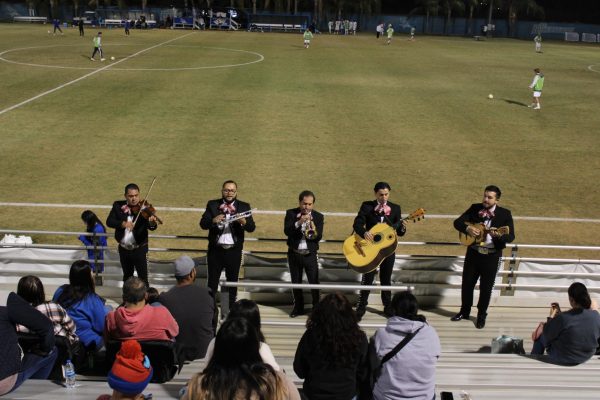Campbell, UC Santa Barbara linguistics professor ‘sheds light on syllable structure’
Eric Campbell, professor of language and linguistics from UC Santa Barbara, demonstrates the difference between tone in Chinese languages on March 14 at the CSU Bakersfield Humanities Office Complex. Bre Parks/The Runner
March 20, 2019
By Sam Underwood
Reporter
We all have fond memories of childhood games like, duck – duck – goose, jump rope, shooting marbles, and Pig Latin. Pig Latin is an example of a play language. A simple children’s game that rearranges syllables and adds syllables to create a language that only those who know the rules, can understand. What you may not know is that many languages from around the world have their own play languages, with individual rules.
A lecture hall in the humanities office building, thursday night, was home to a special event at CSU Bakersfield. On March 14, students and staff gathered for a lecture from guest professor, Eric W. Campbell. This lecture is a part of a series of linguistic lectures, overseen by CSUB professor Sophia Adjaye. The series is hosted by Sigma Tau Delta, the English honors society, and sponsored by the Warren family.
Campbell, a professor of language and linguistics at UC Santa Barbara, lectured on the use of play languages, and how they can be used to break down languages and give insight into their structure.
In basic English classes, students learn about stressed syllables, unstressed syllables, meter, and feet. However, there is an ongoing debate in language and linguistics about the actual structure of a syllable. Campbell explains that Pig Latin has played a significant role in these debates.
Play-languages are significant part of many societies, not only in the English language. As an example of this, Campbell explains the rules to many different play languages from around the world. He includes languages such as: Elvesre – a play language based on Argentinian Spanish, Sorsik Sunmake – the play language based on Kuna, a Chibchan language of Panama, and Warasa – the play language of Siak Malay, a language of Austronesian, Indonesia. Siak Malay, which like many east Asian languages, relies heavily on tones. This becomes significant to the study surrounding play-language because the order of syllables changes the tones, which consequently changes the meaning of a word. The rules to each play-language are slightly different but are structurally the same as Pig Latin. Syllables are rearranged and added based on the rules.
During the lecture, Campbell challenged attendants to try to figure out the play language translations, based on the rules and example words that he displayed on the screen. Students and faculty alike, shouted out translations in foreign languages.
“By looking at these we begin to see how these play languages shed light on syllable structure,” said Campbell.
The language that was prominent in Campbell’s lecture, was nchakwiʔ tzūʔ ntilú, the play language of Zenzontepec Chatino, the indigenous language of Oaxaca, Mexico. Campbell was part of the Chatino Language Documentation Project of 2008, funded by the Endangered Language Documentation Programme. Chatino is being encroached upon by Spanish. Already, the schools, churches, and government are using Spanish as the primary language, slowly erasing Chatino in Oaxaca.
Bailey Russell, 22, senior and dual English and psychology major, said “It was fun and interesting to see the interplay between the play language and the actual language and to see how sometimes there is a pattern between different languages. Yet it is so different for each language at the same time…It was interesting to see how they used [the play language] to analyze the original language.”
Sidney Russell, 22, senior and dual English and psychology major, said that “It was enlightening to see some of the different languages, not just English.”
Samantha Nichols, 28, English graduate student was excited about the topic, and looking forward to further study, “I really enjoyed it and can’t wait till I email him to get his PowerPoint to go in-depth, especially on the sections he had to skip due to time constraints,” she said.







